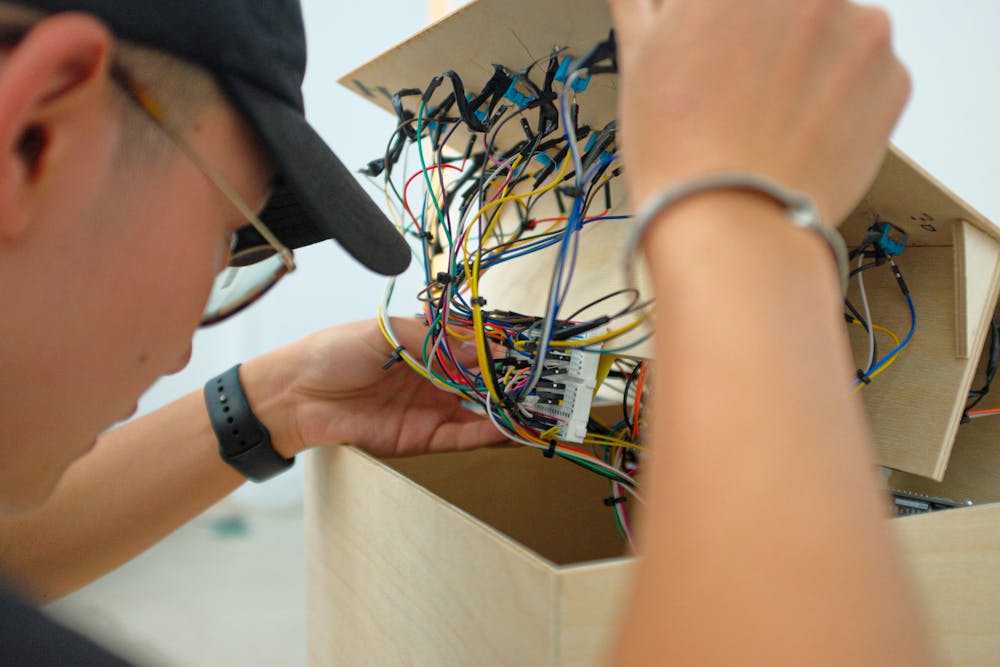‘ones & zeros’ powers digital and interpersonal connection

Photo courtesy Peyton Chiang
Created from plywood, corrugated plastic, Arduino circuits and LED strips, “ones & zeros” was created by senior architecture students Peyton Chiang, Joseph Hsu, Olivia Malone and Jeff Xia for Archi-Arts. The large-scale, interactive exhibition goes on display Wednesday, Aug. 31 at 5 p.m. in the Sewall Courtyard as Sleepy Cyborg’s first fall exhibition, slated to run until Oct. 9.
The project began when the group won $1000 at last year’s Archi-Arts competition.
“We wanted to create something that reflected the idea of the zero and the one, and [we] translated that to the physical motion of switching something on or off,” Chiang, a Duncan College senior, said.
The sculpture is formed from 50 plywood boxes stacked 5 feet wide and 10 feet tall. Each contains an LED strip controlled by an Arduino processor, covered by a sheet of semi-translucent corrugated plastic. The boxes are constructed individually and then screwed together, enabling audience members to flip a switch to turn each box on and off.
“The idea of allowing people to play around with the switches was so that people could leave their mark [and] draw their pattern on this giant analog screen,” Xia, a Brown College senior, said. “After they’re done, they can sit down and see what the next person does.”
The team was heavily inspired by the theme of Archi Arts: 8-BIT. It paid homage to the 8-bit graphic technology that was developed and popularized in the ‘80s and ‘90s and pioneered computer graphics and color images.
“In response to the more technical theme of 8-bit, we wanted to bring in all of our disciplines,” Hsu, a Baker College senior, said. “Jeff has been working on some electronic stuff in an engineering class, and we wanted to combine that with all of our expertise in the woodshop and our architectural knowledge.”
The team ultimately used their combined skills to create a design as simplistic as possible.
“The end product is the result of trying to break down the 8-bit theme to its most basic component,” Malone, a Jones College senior, said. “We wanted to celebrate the simplicity of 8-bit for what it is.”
The team also relied on their architectural skills throughout the artistic process.
“The design process was mostly done through drawings and the computer — just trying to visualize everything. After we won the competition, that’s when we really tuned into how to manifest the project,” Xia said.
From the beginning of the design process the team considered how the audience would experience the installation.
“Another thing we thought about that relates to architecture is how the user was going to interact with the art, the procession to the piece and how the piece would interact with them,” Chiang said.
The boxes are also designed so that the structure can be disassembled and still function.
“At some point we will probably break apart the boxes and distribute them so that people can keep one pixel of the piece,” Xia said.
More from The Rice Thresher

Andrew Thomas Huang puts visuals and identity to song
Houston is welcoming the Grammy-nominated figure behind the music videos of Björk and FKA twigs on June 27.

Live it up this summer with these Houston shows
Staying in Houston this summer and wondering how to make the most of your time? Fortunately, you're in luck, there's no shortage of amazing shows and performances happening around the city. From live music to ballet and everything in between, here are some events coming up this month and next!

Review: 'Adults' couldn’t have matured better
Sitcoms are back, and they’re actually funny. FX’s “Adults” is an original comedy following a friend group navigating New York and what it means to be an “actual adult.” From ever-mounting medical bills to chaotic dinner parties, the group attempts to tackle this new stage of life together, only to be met with varying levels of success.

Please note All comments are eligible for publication by The Rice Thresher.